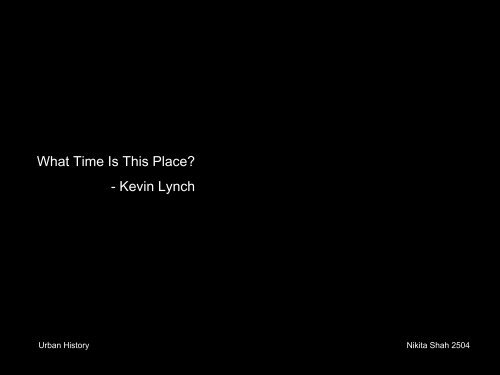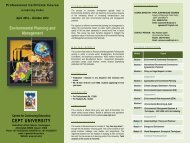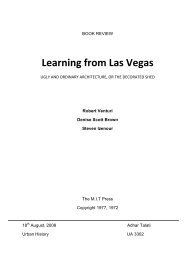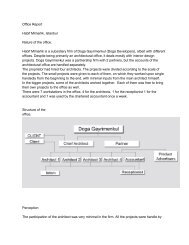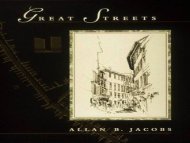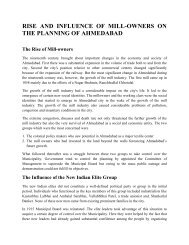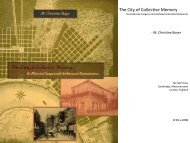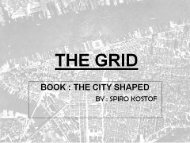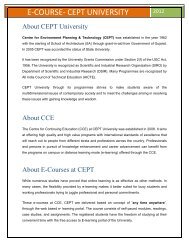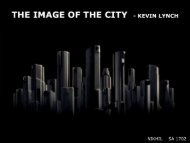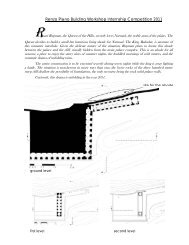You also want an ePaper? Increase the reach of your titles
YUMPU automatically turns print PDFs into web optimized ePapers that Google loves.
<strong>What</strong> <strong>Time</strong> <strong>Is</strong> <strong>This</strong> <strong>Place</strong>?<br />
Urban History<br />
- <strong>Kevin</strong> <strong>Lynch</strong><br />
Nikita Shah 2504
The book talks about human sense of time, the biological time that body follows<br />
more than the external time which is there in the physical world.<br />
The author’s argument is that this biological rhythm affects the way we view our<br />
environment and the environment we live in shapes our image of time.<br />
And so an individual’s image of time should be of consideration when we<br />
change the environment.<br />
The world around us changes continually, so we can do is the management of<br />
change.<br />
<strong>What</strong> time is this place?
Cities Transforming<br />
In the first chapter the author explains few cases of environment change like in<br />
situations of disaster, renewal, growth, revolution etc.<br />
In case of these changes people try to preserve or recreate the past as it gives<br />
them a familiarity and a secure sense of future.<br />
People sense the change not only as the physical change but also as a flow of<br />
time. The flow of time is connected to their hopes and memories.<br />
Here a place is explained as a symbol of past, present or future time, as a<br />
image of time in a person’s mind.<br />
<strong>What</strong> time is this place?
The Presence of the Past<br />
<strong>This</strong> image of time is mostly conveyed very directly. Ruins are romanticized.<br />
Historical buildings are preserved as relics of time gone by, even when they are<br />
irrelevant to their context, incapable of communicating their meaning of<br />
existence to the public, or explaining the relevance of cost and time that goes<br />
for preservation and difficulties they generate for new development.<br />
<strong>Kevin</strong> <strong>Lynch</strong> suggests here “though the landscape should have the imprint of<br />
human events and seem connected with living persons, the imprints and<br />
connections must eventually fade away and be forgotten, just as human<br />
memories and generations fade”.<br />
<strong>What</strong> time is this place?<br />
A surviving fragment of the marble map<br />
of imperial Rome indicates the theater of<br />
Pompey.<br />
In the same area of Rome today, there<br />
are traces of the former structure.
The <strong>Time</strong> Inside<br />
According to <strong>Kevin</strong> <strong>Lynch</strong> the image of the time should be of present while<br />
understanding the connection to the past and future while keeping in mind the<br />
possibility and importance of change.<br />
Recalling and learning is a way to link with past and future. Any environment<br />
should provide that. A person’s time or rhythm should be synchronized to the<br />
rhythm of the world.<br />
An individual’s image of time should be constant with the changing worldly facts<br />
and also with changing human ways of thinking and feeling.<br />
<strong>This</strong> image would be a guide to that individual’s actions and a basis for<br />
providing human existence with meaning.<br />
The form of external environment can modify this image of time and the author<br />
discusses how the management of change in environment can lead to the<br />
expansion of individual’s image of time.<br />
<strong>What</strong> time is this place?
Signs of time..<br />
<strong>What</strong> time is this place?
A digital clock tell us when we are to the nearest 1/1440 of a day..<br />
<strong>What</strong> time is this place?
People can tell time by the sun, by watching the shadow..<br />
<strong>What</strong> time is this place?
People can tell time by watching the crowds and what they are carrying, by listening to<br />
the level of noise, or by seeing that shops are closed.<br />
<strong>What</strong> time is this place?
There are other indicators of time on the street. In the morning and evening the traffic<br />
swells, the traffic light runs slow.<br />
<strong>What</strong> time is this place?
Some Signs, markers and objects tell us of the time they belong to..<br />
<strong>What</strong> time is this place?
When a building or a part of it comes down, it leaves traces of its function on the<br />
surrounding walls..<br />
<strong>What</strong> time is this place?
On a busy corner, time seems to pass rapidly..<br />
<strong>What</strong> time is this place?
When people wait, they measure the empty passage of time..<br />
<strong>What</strong> time is this place?
In the evening, the lights come on and the city changes..<br />
<strong>What</strong> time is this place?
The old and new construction..<br />
<strong>What</strong> time is this place?
The old and new construction..<br />
<strong>What</strong> time is this place?
Some Policies for Changing Things<br />
The work schedules should be according to individual’s body time. Unnecessary<br />
rigidities can be removed and more individual variation in timing should be<br />
allowed.<br />
With other public functions, providing people with information about future<br />
should also become a public function.<br />
Current intentions of any policy and probable near futures by social and<br />
environmental forecasting should be informed to people.<br />
Exploration of future can be done with action research with some prototypes.<br />
<strong>This</strong> prototype centers will make experimenter and subject as one and will<br />
explore and test future alternatives.<br />
Different people would like to feel time passing at different rates. The choice<br />
among ways of structuring time should be increased.<br />
Our environment should be conserved but not preserved. The change will<br />
always happen, all we should do is to make it a humane process.<br />
<strong>What</strong> time is this place?


